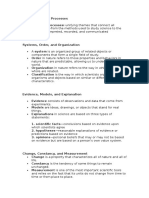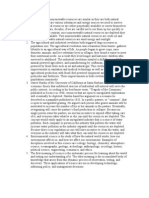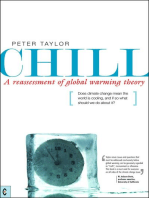List The Properties That Distinguish Science From Other Fields of Inquiry
Uploaded by
Sarah SalapuddinList The Properties That Distinguish Science From Other Fields of Inquiry
Uploaded by
Sarah Salapuddin1. List the properties that distinguish science from other fields of inquiry.
Science has characteristics that set it apart from other fields of research. It is a systematized
knowledge derived from and tested by recognition and formulation of a problem, collection of
data through observation, and experimentation.
2. Differentiate between natural science and social science.
Social science is a subfield of science that studies human society and interpersonal connections,
such as individuals, communities and societies; their behaviors and interactions with each other
and with their built, technological and natural environments. Whereas natural science is a
subfield of science that studies the natural environment, such as such diverse disciplines as
biology, chemistry, geology, physics, and environmental science.
We differentiate between social science and natural science in that the former deals with the
study of people and how they live together as families, tribes, communities, races, and nations,
and the latter deals with the study of nature and the physical world.
3. List three disciplines of natural science.
Natural sciences are academic disciplines that collectively use empirical evidence to
comprehend and explain the physical world. Natural science includes such diverse disciplines as
chemistry, physics, and environmental science.
4. Define environmental science.
Environmental science in its broadest sense encompasses all the fields of natural science. The
term 'environmental science' refers to a grouping of scientific disciplines that are all concerned
with the physical, chemical and biological characteristics of the surroundings in which organisms
live. The historical focus of study for environmental scientists has been, of course, the natural
environment. By this, we mean the atmosphere, the land, the water and their inhabitants as
differentiated from the built environment. Some examples of environmental sciences include
human ecology and climate change science. These are environmental sciences because they
study the interactions and impacts of humans on and within their environment. Modern
environmental science has also found applications to the built environment or, perhaps more
correctly, to the effusions from the built environment.
5. Explain the advantage of a theory over a collection of ideas.
Theories provide a framework for understanding human behavior, thought, and development.
Each theory provides a context for understanding a certain aspect of human behavior. By having
a broad base of understanding about the how's and why's of human behavior, we can better
understand ourselves and others. Building a strong theoretical framework can help researchers
identify what aspects of current theories are well understood, which aspects have yielded
conflicting findings, and, importantly for AMJ, where the authors can build, extend, and offer
bold alternative thinking. While the collection of ideas can established a systematic fashion that
enables one to answer stated research questions, test hypotheses, and evaluate outcomes but it
may take some time to gather thoughts or to evaluate documents and information. Additionally,
because the researcher has less control over the outcomes and some records might not be
readily accessible to the public, this form of data gathering might be insufficient.
Furthermore, a theory gives us a powerful new tool in the acquisition of knowledge for it shows
us where to look for new generalizations. “Thus, the accumulation of data becomes less of a
magpie collection of facts and more of a systematized hunt for needed information. It is the
existence of classification and generalization, and above all theory that makes science an
organized body of knowledge” (Wright, 1964).
6. Describe the advantage of a quantitative theory over a qualitative one.
Quantitative theories are tools tested using particular statistical methods: theories are
constructed logically from what is already known about the topic, considering the feasibility of
measuring the concepts or variables in the theory. It is often seen as more accurate or valuable
than qualitative theories, which focuses on gathering non-numerical data. Quantitative theories
are also easier to conduct, but require more participants than qualitative theories/studies. It is
also more preferred over qualitative theory because it is more scientific, objective, focused and
acceptable. It allows for a broader study, involving a greater number of subjects, and enhancing
the generalization of the results; Allows for greater objectivity and accuracy of results.
Specifically, data collection in quantitative theories tend to require less time commitment from
participants, and the data analysis can be conducted relatively quickly than the qualitative
theory.
7. Sketch and label a water resource e system, including (a) source, (b) collection works,
(c) transmission works, (d) treatment works, and (e) distribution works.
8. State the proper general approach to treatment of a surface water and a groundwater (see
Figure 1–6).
9. Define the word demand as it applies to water.
Demand is an insistent and peremptory request, made as if by right. Water demand is defined as
the volume of water requested by users to satisfy their needs. In a simplified way it is often
considered equal to water abstraction, although conceptually the two terms do not have the
same meaning. Water is necessary for urban development, power production, growing and
processing high-value crops, oil and gas development and processing, and industrial
manufacturing. Satisfying all of these competing needs requires a better understanding of water
resources and new approaches to water management.
10. List the five most important factors contributing to water consumption and explain why
each has an effect.
11. State the rule-of-thumb water requirement for an average city on a per-person basis and
calculate the average daily water requirement for a city of a stated population.
12. Define the acronyms WWTP and POTW.
13. Explain why separate storm sewers and sanitary sewers are preferred over combined sewers.
14. Explain the purpose of a lift station.
15. Discuss the role of environmental ethics in environmental engineering and environmental
science.
You might also like
- The Comparative Method: Moving Beyond Qualitative and Quantitative StrategiesFrom EverandThe Comparative Method: Moving Beyond Qualitative and Quantitative Strategies5/5 (1)
- Summary of Thomas S. Kuhn's The Structure of Scientific RevolutionsFrom EverandSummary of Thomas S. Kuhn's The Structure of Scientific RevolutionsNo ratings yet
- A Treatise on Anatomy, Physiology, and Hygiene (Revised Edition)From EverandA Treatise on Anatomy, Physiology, and Hygiene (Revised Edition)No ratings yet
- Discerning Experts: The Practices of Scientific Assessment for Environmental PolicyFrom EverandDiscerning Experts: The Practices of Scientific Assessment for Environmental PolicyNo ratings yet
- Research in Information Studies: A Cultural and Social ApproachFrom EverandResearch in Information Studies: A Cultural and Social ApproachNo ratings yet
- Big Data, Little Data, No Data: Scholarship in the Networked WorldFrom EverandBig Data, Little Data, No Data: Scholarship in the Networked World2.5/5 (2)
- Ecological Engineering Design: Restoring and Conserving Ecosystem ServicesFrom EverandEcological Engineering Design: Restoring and Conserving Ecosystem Services3/5 (1)
- Hybrid Epistemology as a Solution to Reductionism-Physicalism Issues: Predictability in Physics and How it Has Formulated Validity Principles of Authentic InferenceFrom EverandHybrid Epistemology as a Solution to Reductionism-Physicalism Issues: Predictability in Physics and How it Has Formulated Validity Principles of Authentic InferenceNo ratings yet
- Environmental Information Science A Course at TheNo ratings yetEnvironmental Information Science A Course at The5 pages
- Doing Global Science: A Guide to Responsible Conduct in the Global Research EnterpriseFrom EverandDoing Global Science: A Guide to Responsible Conduct in the Global Research EnterpriseNo ratings yet
- Basic Physics for Beginners: A Comprehensive Study Guide for the Self-Taught ScientistFrom EverandBasic Physics for Beginners: A Comprehensive Study Guide for the Self-Taught ScientistNo ratings yet
- Choosing a Research Method, Scientific Inquiry:: Complete Process with Qualitative & Quantitative Design ExamplesFrom EverandChoosing a Research Method, Scientific Inquiry:: Complete Process with Qualitative & Quantitative Design ExamplesNo ratings yet
- The Eternal Return: Reproduction and Change in Complex Activity System - The Case of Salmon EnhancementFrom EverandThe Eternal Return: Reproduction and Change in Complex Activity System - The Case of Salmon EnhancementNo ratings yet
- Chill, A Reassessment of Global Warming Theory: Does Climate Change Mean the World is Cooling, and If So What Should We Do About It?From EverandChill, A Reassessment of Global Warming Theory: Does Climate Change Mean the World is Cooling, and If So What Should We Do About It?4.5/5 (1)
- Environmental Science Guide and CoorelationNo ratings yetEnvironmental Science Guide and Coorelation25 pages
- Learning Outcomes: College of Arts and SciencesNo ratings yetLearning Outcomes: College of Arts and Sciences5 pages
- Spatio-temporal Approaches: Geographic Objects and Change ProcessFrom EverandSpatio-temporal Approaches: Geographic Objects and Change ProcessNo ratings yet
- Physics and Chemestry Bimestre 1 Marzo 09No ratings yetPhysics and Chemestry Bimestre 1 Marzo 094 pages
- In Salah Gas Project Engineering Procurement & Construction PhaseNo ratings yetIn Salah Gas Project Engineering Procurement & Construction Phase17 pages
- Galactic Human - Handbook - Nidle, Sheldon Argüelles, José A - (José Anthony), 1939 - Forres, 1995 - Forres - Altea Pub - 9780952455554 - Anna's ArchiveNo ratings yetGalactic Human - Handbook - Nidle, Sheldon Argüelles, José A - (José Anthony), 1939 - Forres, 1995 - Forres - Altea Pub - 9780952455554 - Anna's Archive180 pages
- Mock Clat - 21 Answer and Explanation: Section-I: EnglishNo ratings yetMock Clat - 21 Answer and Explanation: Section-I: English24 pages
- Gateway College of Architecture and Design SONIPAT 131001No ratings yetGateway College of Architecture and Design SONIPAT 13100151 pages
- Urea, Blood ,: Test Name Result Biological Ref. Interval MethodNo ratings yetUrea, Blood ,: Test Name Result Biological Ref. Interval Method4 pages
- Handout+Home Assignment For CSE 2022 BATCHNo ratings yetHandout+Home Assignment For CSE 2022 BATCH7 pages
- MBA - II - WHGSM - Supply Chain - Seminar ReportNo ratings yetMBA - II - WHGSM - Supply Chain - Seminar Report36 pages
- Honey Powder Extract - LC-232267 - HC - He - F - 2023 - O2267No ratings yetHoney Powder Extract - LC-232267 - HC - He - F - 2023 - O22672 pages
- Hamdard Institute of Management Sciences Final Examination - Spring 2020No ratings yetHamdard Institute of Management Sciences Final Examination - Spring 20204 pages
- Geography Chapter 34-The Pacific World and AntarcticaNo ratings yetGeography Chapter 34-The Pacific World and Antarctica3 pages
- Manual For Rehabilitating Large Dams 20170527No ratings yetManual For Rehabilitating Large Dams 20170527123 pages

























































































